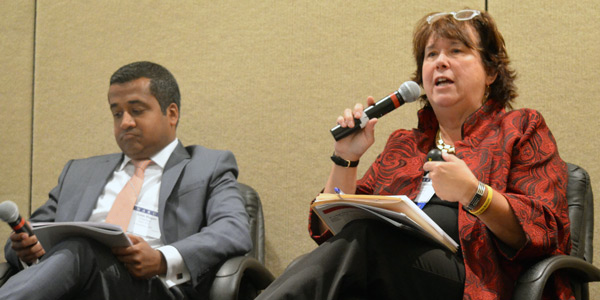By Robert Mullin
LA QUINTA, Calif. — State commissions have a significant part to play in shaping RTO rules, but they must actively seek a place at the table when key decisions are being made, regulators and RTO representatives said during a panel discussion at the National Association of Regulatory Utility Commissioners annual conference last week.
Another takeaway: States will exercise more influence in the process when they cooperate with each other and strive to speak with a common voice.
Vermont Public Service Board Member Sarah Hoffman, the panel moderator, kicked off the discussion with a close-to-home example of the often-complicated relationship between states and RTOs.
New England’s IMAPP

Hoffman cited the challenges facing New England’s Integrating Markets and Public Policy (IMAPP) stakeholder process, which seeks to identify changes needed to align the region’s wholesale market with individual state energy policies, particularly those related to renewable energy. The goal of the process is to translate state policies into market rules that ISO-NE can adopt.
“It is a process that is ongoing and that has really put the states into the center of the discussion about how we are going to integrate these public policies” into the market, Hoffman said.
But it hasn’t been seamless.
“Generators and suppliers want to tear their hair out because the six states don’t all want the same thing,” Hoffman said. “Where Massachusetts wants 1,600 MW of offshore wind, Vermont has different requirements. Market participants would prefer that all the states share the same requirements.
“Based on the fact that we all have legislators, that’s never going to happen,” she added.
State Discord in PJM
“If all of the PJM states can be on the same page, that is very effective advocacy,” said Asim Haque, chairman of the Public Utilities Commission of Ohio.
That kind of unity is desirable whether the states are dealing with a “ground-up” state-initiated policy or a “top-down” PJM initiative, he said.
“The intrigue lies in when states do not agree,” Haque said.
Haque noted that the Organization of PJM States Inc. requires a 51% vote to take a policy position.
“If you’re not able to get that 51% and the states start going it alone on an issue, I think it creates a little friction between the states,” Haque said.
MISO: Not a Distraction

Indiana Utility Regulatory Commissioner Angela Weber emphasized the need for regulators to be engaged with their RTOs.
“There are a lot of commissioners who just aren’t engaged, and I think the idea is that [state commissions] don’t have jurisdiction over the RTO, so it doesn’t matter,” she said.
Weber said her work on the Organization for MISO States can seem like a distraction from state-related work, but she considers her involvement to be vital for her state’s residents.
She pointed out that MISO has approved more than $25 billion in transmission spending since 2003.
“All these costs flow through to our ratepayers,” Weber said. “If regulators in MISO want to have influence on these costs, they are better off doing so at the MISO level before the costs get passed on.”
Weber also pointed to an essential connection between state commissions and RTOs.
“There’s an intersection between the RTO’s responsibility to maintain reliability and the state regulator’s responsibility for ensuring resource adequacy,” Weber said. Through their resource planning processes, “the states effectively determine the tools that MISO has at its disposal to maintain reliability,” she said.
SPP Model

SPP General Counsel Paul Suskie said states wield significant influence within his RTO through the Regional State Committee. The committee has governing authority over transmission access charges, financial transmission rights, planning for remote resources and resource adequacy, while also providing input into market developments, strategy and transmission planning.
“Our CEO will tell you that when he said we were going to give state regulators this authority, some of his counterparts thought he was crazy, that it’s not going to work,” Suskie said.
The SPP model works because of the time and effort state commissions dedicate to working through market issues, Suskie said.
“Other states ask me about our governance model and I tell them, ‘From the state commissioner perspective, the good thing is you have the authority. The bad thing is you have the authority,’” Suskie said.
CAISO Seeks to Evolve

Stacey Crowley, vice president of regional and federal affairs at CAISO, said that a change in governance is key for enabling the ISO to expand into other parts of the West. The ISO was created in 1998 as a single-state body under California statute, with board members appointed by the governor.
That structure “will not satisfy a regional ISO,” Crowley said.
Crowley noted that regional discussions about a Western RTO have focused on the fact that each state has different policy structures, goals and procurement strategies.
“Those are all important and need to be respected in a regional ISO,” Crowley said.
While California represents a large population in the West, “its policies need to be seen as equal amongst all the states” in an RTO, she added.
CAISO has developed a model for state involvement with its Energy Imbalance Market, which features a regionally representative governing body and an advisory body of regulators that provides states with a forum to discuss market issues.
“It’s been a good way to develop a relationship and a way to communicate amongst the states,” Crowley said.




